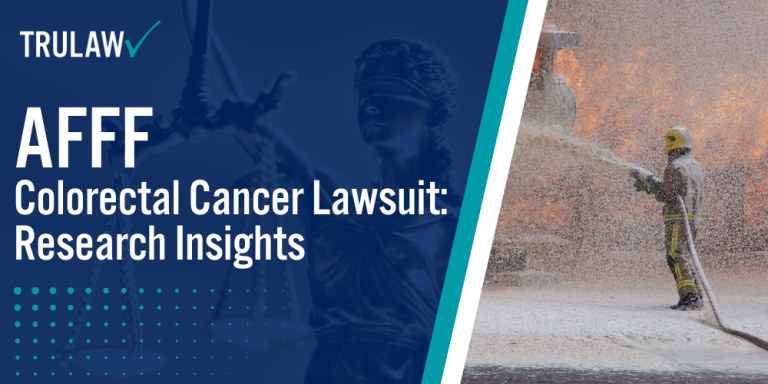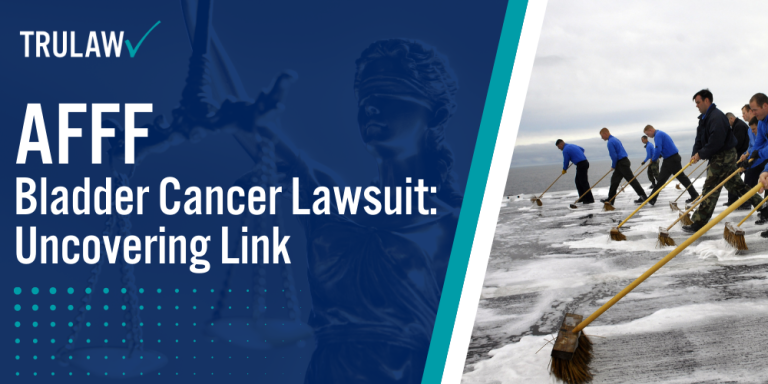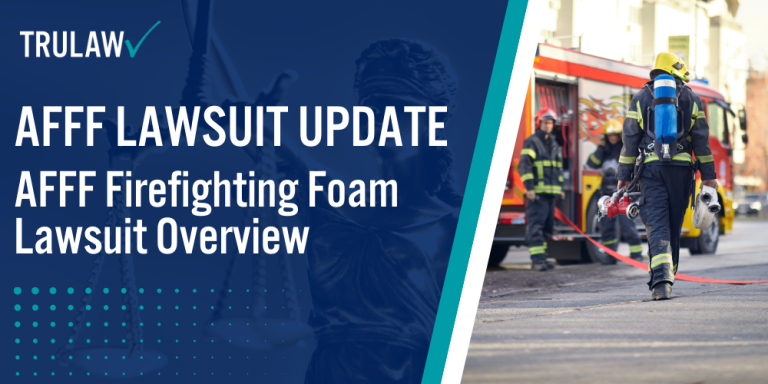Firefighting Foam Cancer Lawsuit: AFFF Exposure Risk
- Last Updated: July 9th, 2024

Attorney Jessie Paluch, founder of TruLaw, has over 25 years of experience as a personal injury and mass tort attorney, and previously worked as an international tax attorney at Deloitte. Jessie collaborates with attorneys nationwide — enabling her to share reliable, up-to-date legal information with our readers.
Legally Reviewed
This article has been written and reviewed for legal accuracy and clarity by the team of writers and legal experts at TruLaw and is as accurate as possible. This content should not be taken as legal advice from an attorney. If you would like to learn more about our owner and experienced injury lawyer, Jessie Paluch, you can do so here.
Fact-Checked
TruLaw does everything possible to make sure the information in this article is up to date and accurate. If you need specific legal advice about your case, contact us by using the chat on the bottom of this page. This article should not be taken as advice from an attorney.
Key takeaways:
- 1. Firefighters and military personnel face heightened risks of developing certain cancers, like prostate, kidney and testicular cancer, due to occupational exposure to PFAS chemicals in AFFF firefighting foam.
- 2. Individuals who suspect AFFF exposure illness should seek prompt medical diagnosis, document symptoms, and exposure history, and consult with experienced firefighting foam lawyers to explore their legal options.
- 3. TruLaw is a leading law firm representing clients in AFFF firefighting foam lawsuits, helping cancer victims seek justice and compensation from negligent manufacturers.
Overview of Firefighting Foam Cancer
On this page, we’ll discuss Firefighting Foam Cancer, the types of cancer linked to AFFF exposure, how to seek medical care and legal support for AFFF-related cancer, and much more.
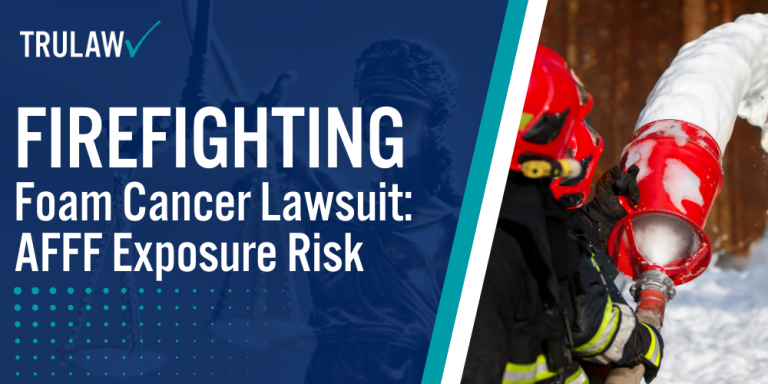
Intro to Firefighting Foam Cancer
Exposure to AFFF firefighting foam has been linked to several types of cancer, including:
- Testicular Cancer: Studies have shown a higher incidence of testicular cancer among individuals exposed to AFFF.
- Kidney Cancer: PFAS chemicals in AFFF have been associated with an increased risk of kidney cancer.
- Pancreatic Cancer: Research suggests that exposure to AFFF may lead to a higher likelihood of developing pancreatic cancer.
- Bladder Cancer: Individuals exposed to AFFF have been found to have a greater risk of bladder cancer compared to the general population.
If you have been diagnosed with cancer after being exposed to AFFF, you may be eligible for compensation through a firefighting foam cancer lawsuit.
Contact TruLaw using the chat feature on this page for a free case evaluation to learn more about your legal options and how to hold those responsible for your AFFF-related cancer accountable.
Table of Contents
Health Hazards Associated with AFFF Exposure
Exposure to Aqueous Film Forming Foam (AFFF) has raised significant health concerns due to the presence of perfluoroalkyl and polyfluoroalkyl substances (PFAS).
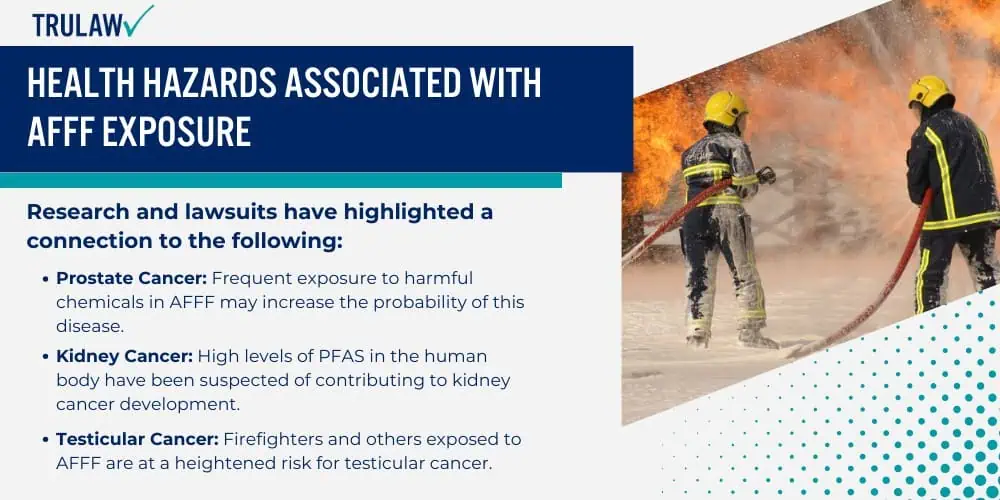
These toxic chemicals persist in the environment and have been associated with several types of cancer and other health issues.
Types of Cancers Linked to Firefighting Foam
PFAS exposure from firefighting foams has been linked to a higher risk of developing certain cancers.
Research and lawsuits have highlighted a connection to the following:
- Prostate Cancer: Frequent exposure to harmful chemicals in AFFF may increase the probability of this disease.
- Kidney Cancer: High levels of PFAS in the human body have been suspected of contributing to kidney cancer development.
- Testicular Cancer: Firefighters and others exposed to AFFF are at a heightened risk for testicular cancer.
- Kidney and Testicular Cancer: Both of these cancers are of particular concern to professionals who work with firefighting foams.
Environmental Protection Agency (EPA) and National Fire Protection Association studies support these findings, reinforcing the need for scrutiny and regulation of these substances.
Other Potential Health Problems Caused by PFAS
In addition to cancer, AFFF exposure is associated with several other potential health problems.
Key health risks include:
- Thyroid Disease: Disruption of normal thyroid function is a major concern.
- Immune System: PFAS can lead to adverse effects on immune health, possibly affecting vaccine efficacy and immune response.
- Human Health: Beyond specific diseases, PFAS have been linked to a range of adverse health effects that impact overall well-being.
- Occupational Safety: Workers in industries using AFFF must be aware of potential health hazards and adhere to safety guidelines.
The Centers for Disease Control and Prevention (CDC) and agencies focused on disease control and occupational safety continue to study these effects on human health to develop appropriate interventions.
Occupations at Highest Risk for AFFF-Related Cancers
Individuals working in certain occupations, particularly firefighters and military personnel, face a notably increased risk of developing cancer due to exposure to aqueous film-forming foam (AFFF) containing per- and polyfluoroalkyl substances (PFAS).
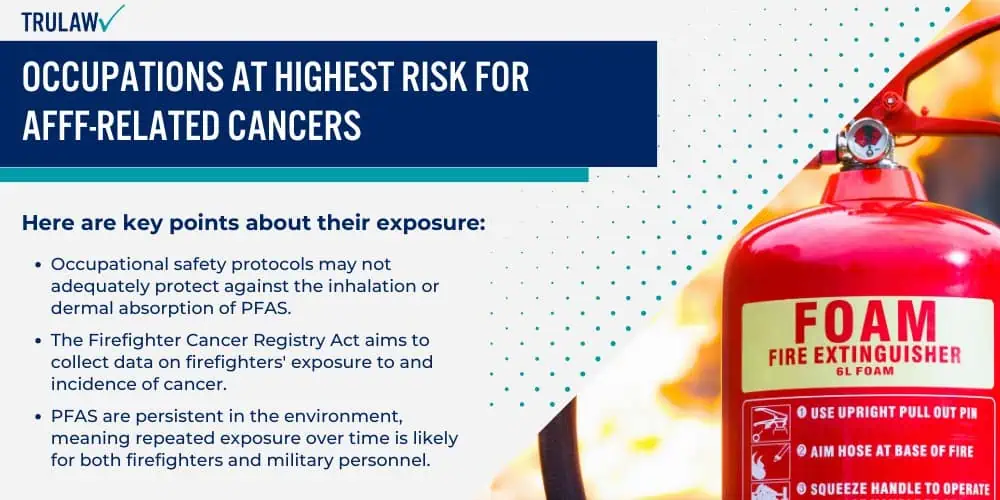
Firefighters and Military Personnel Exposure
Firefighters at airports and in local fire departments regularly encounter AFFF during routine firefighting and firefighting training exercises.
It’s used for extinguishing fuel fires, which are high-temperature and fast-spreading.
Military firefighters have similar exposure risks, especially during aircraft-related incidents.
Here are key points about their exposure:
- Occupational safety protocols may not adequately protect against the inhalation or dermal absorption of PFAS.
- The Firefighter Cancer Registry Act aims to collect data on firefighters’ exposure to and incidence of cancer.
- PFAS are persistent in the environment, meaning repeated exposure over time is likely for both firefighters and military personnel.
- Toxic firefighting foam has been linked to contaminated drinking water sources around military bases and fire training areas.
Occupational exposure to these substances, especially over extended periods or without proper protective equipment, increases the likelihood that these professionals will develop health complications related to PFAS contamination.
How PFAS Enter the Body and Accumulate
PFAS can enter the body through various pathways and are known to accumulate over time.
This accumulation can lead to a build-up of these toxic substances.
Let’s consider how PFAS commonly make their way into the body:
- Inhalation of contaminated air during firefighting activities.
- Ingestion of contaminated drinking water from nearby areas where AFFF has been used.
- Absorption through the skin during direct contact with PFAS-containing foams or contaminated surfaces.
- Consumption of food grown in PFAS-contaminated soil or water.
Once in the body, PFAS bind to proteins and can remain there for a long time due to their chemical structure, which resists breakdown.
This persistent presence in the body intensifies concerns about long-term health effects, including an increased risk of developing cancer.
Criteria to Qualify for Firefighting Foam Lawsuit
When considering involvement in an AFFF lawsuit, eligibility hinges on meeting specific criteria related to exposure and resulting health conditions.
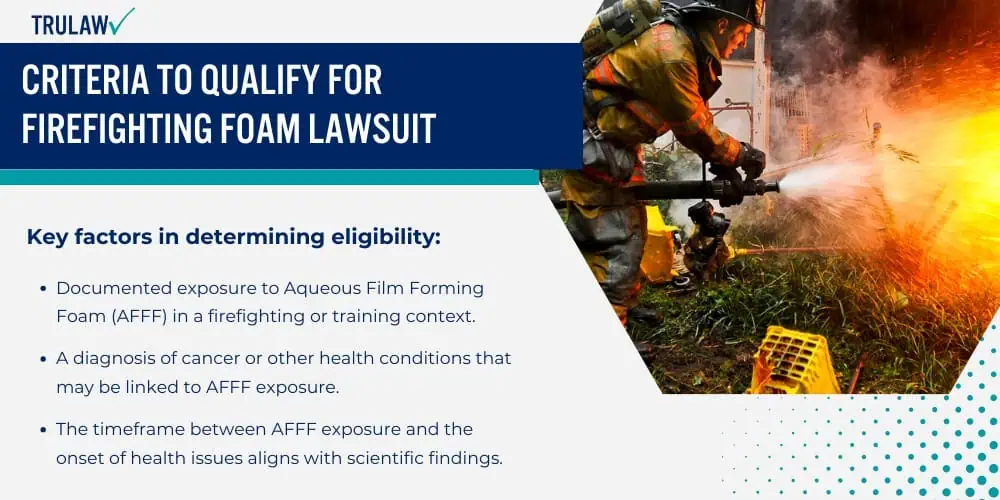
Claimants typically must demonstrate a link between their illness and the fire suppressant foam.
Specific Requirements to File an AFFF Claim
To file a claim related to AFFF exposure, individuals must meet specific criteria to demonstrate a connection between their health issues and exposure to firefighting foam.
The process involves gathering medical records and other evidence to support the claim’s validity.
Key factors in determining eligibility:
- Documented exposure to Aqueous Film Forming Foam (AFFF) in a firefighting or training context.
- A diagnosis of cancer or other health conditions that may be linked to AFFF exposure.
- The timeframe between AFFF exposure and the onset of health issues aligns with scientific findings.
- Representation by firefighting foam lawyers knowledgeable about the certainly complex AFFF MDL and class action processes.
Potential Compensation in Successful Lawsuits
Successful lawsuits can result in various forms of compensation for claimants, depending on the severity of their condition and its impact on their lives.
These settlements aim to address the harm caused by negligence, providing financial relief to help cover medical bills and other damages.
Claimants may be entitled to:
- Coverage of medical expenses, both past and future, related to the illness.
- Compensation for lost wages if the illness has impacted their ability to work.
- Damages for pain, suffering, and the diminished quality of life.
- In some AFFF cancer cases, punitive damages may be awarded if negligence by the AFFF manufacturers is proven.
Each AFFF firefighting foam lawsuit settlement or verdict depends on the case’s unique circumstances, and the financial compensation may vary greatly.
Claimants have joined the AFFF MDL to seek accountability and restitution.
Time Limits to File Firefighting Foam Lawsuits
When pursuing AFFF personal injury claims, it’s imperative to understand that each state sets its own deadlines, known as statutes of limitations, which dictate how long plaintiffs have to initiate legal proceedings.
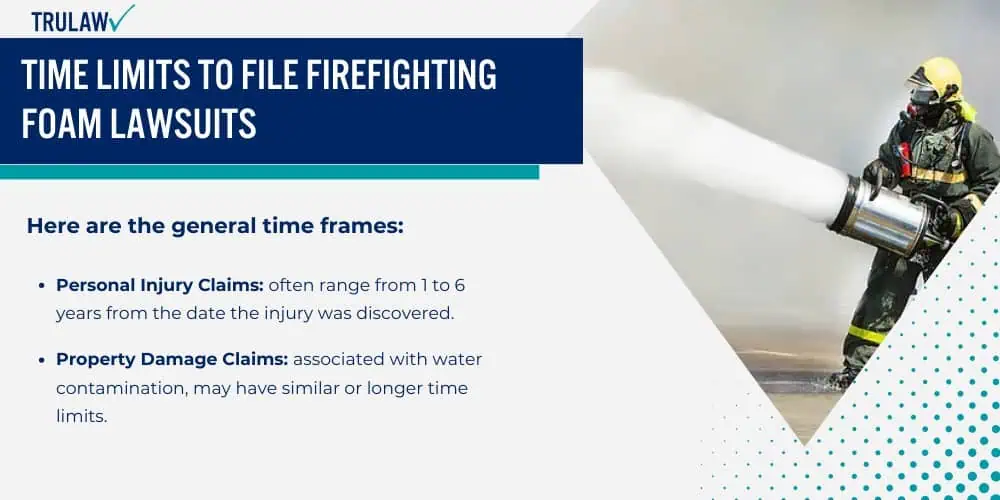
Missing these deadlines can result in the loss of the right to compensation.
Statutes of Limitations by State for AFFF Claims
Statutes of limitations vary significantly from state to state, and they can affect both personal injury and municipal water contamination claims.
Here are the general time frames:
- Personal Injury Claims: often range from 1 to 6 years from the date the injury was discovered.
- Property Damage Claims: associated with water contamination, may have similar or longer time limits.
Some states may have specific statutes of limitations extensions known as “discovery rules,” which extend the time limit based on when the harm was discovered.
For AFFF cancer lawsuits, many states are considering or have enacted legislation to accommodate the unique circumstances of PFAS exposure and its latent effects on health.
It is important to consult a knowledgeable lawyer who specializes in environmental claims to understand the specific limitations applicable to an AFFF-related lawsuit.
Importance of Consulting an Experienced Lawyer
Firefighting foam lawsuits often involve complex legal issues and scientific evidence that require specialized knowledge.
Consulting with an experienced lawyer helps you understand the nuances of your case and increases your chances of a favorable outcome.
An experienced firefighting foam attorney is essential due to the intricacies of these lawsuits:
- They can advise on the statute of limitations in your state and any exceptions that may apply to your case.
- A competent law firm can assist in investigating the claim, considering the prolonged latency periods of some cancers associated with AFFF.
- They will guide you through filing to ensure you meet all procedural requirements within the set deadlines.
- Firefighting foam attorneys are vital in managing claims involving complex evidence and extensive documentation.
By engaging a law firm with expertise in the field, plaintiffs can navigate the legal landscape more easily and ensure timely filing of their claims.
TruLaw: Leading AFFF firefighter Lawsuit Firm
TruLaw has established itself as a formidable name in representing clients affected by illnesses tied to Aqueous Film Forming Foam (AFFF).
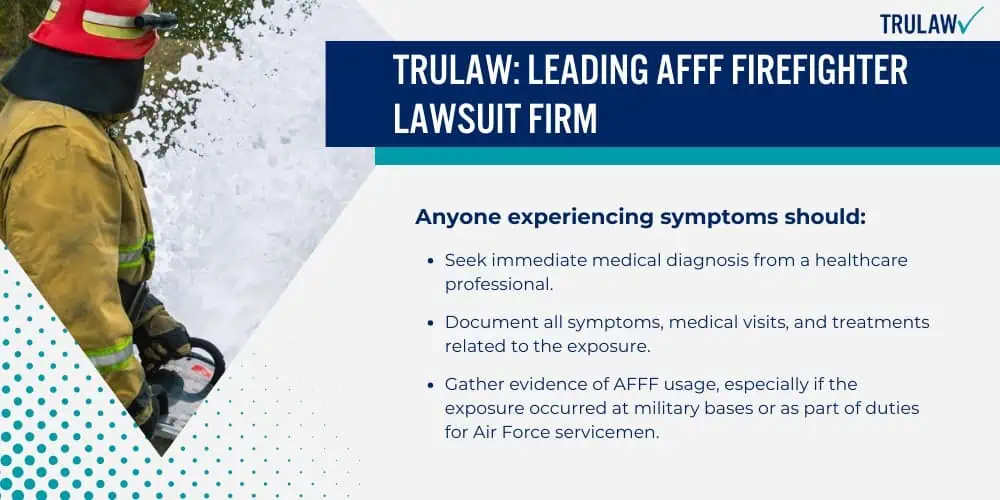
Their expertise in AFFF firefighting foam lawsuits is significant for individuals who develop cancer linked to toxic exposure.
What to Do if You Suspect AFFF Exposure Illness
Recognizing the signs and taking the right steps can be vital after suspecting illness from AFFF exposure.
Anyone experiencing symptoms should:
- Seek immediate medical diagnosis from a healthcare professional.
- Document all symptoms, medical visits, and treatments related to the exposure.
- Gather evidence of AFFF usage, especially if the exposure occurred at military bases or as part of duties for Air Force servicemen.
- Consult with legal experts like TruLaw to guide you through the legal process.
History of Firefighting Foam Usage and Risks
Firefighting foam, particularly AFFF, has been widely used to extinguish fires, especially those involving flammable liquids.
Historical risks associated with its use include:
- The presence of dangerous chemicals in AFFF that have been linked to various cancers.
- Reports from Air Force bases indicating equipping airport firefighters with personal protective equipment may have been insufficient to prevent exposure.
- Incremental awareness of health risks resulting in tighter safety precautions and regulations regarding AFFF use.
- The substantiation of several cancer diagnoses among those with extended exposure to film-forming foam AFFF, propelling legal actions such as AFFF personal injury and firefighting foam cancer lawsuits.
Frequently Asked Questions
-
What settlement amounts have been awarded in AFFF lawsuits?
Settlement amounts in AFFF lawsuits vary widely, reflecting the specifics of each case.
They consider factors such as the extent of exposure and associated health impacts.
-
What are the latest updates on firefighting foam lawsuits?
Currently, firefighting foam lawsuits are progressing through courts, with some AFFF personal injury cases achieving settlements while others are scheduled for trial.
Legal developments occur frequently as litigation continues.
-
Which types of cancer are associated with AFFF foam exposure?
Research and lawsuits have linked AFFF foam exposure primarily to kidney, testicular, pancreatic, and prostate cancers.
Medical studies suggest that PFAS chemicals in these foams may increase cancer diagnosis risk.
-
Who is eligible to participate in the AFFF lawsuits?
Individuals directly exposed to AFFF, such as firefighters or those who’ve lived in contaminated areas, and have developed health issues, may be eligible.
Eligibility extends to those who can connect their condition and AFFF exposure.
-
Are there any links between firefighting foam and cancer risk?
Exposure to certain PFAS chemicals in firefighting foams has been linked to an increased risk of cancer.
Ongoing litigation and research aim to clarify the causal relationships.

Experienced Attorney & Legal SaaS CEO
With over 25 years of legal experience, Jessie is an Illinois lawyer, a CPA, and a mother of three. She spent the first decade of her career working as an international tax attorney at Deloitte.
In 2009, Jessie co-founded her own law firm with her husband – which has scaled to over 30 employees since its conception.
In 2016, Jessie founded TruLaw, which allows her to collaborate with attorneys and legal experts across the United States on a daily basis. This hypervaluable network of experts is what enables her to share reliable legal information with her readers!
You can learn more about the AFFF Lawsuit by visiting any of our pages listed below:
Here, at TruLaw, we’re committed to helping victims get the justice they deserve.
Alongside our partner law firms, we have successfully collected over $3 Billion in verdicts and settlements on behalf of injured individuals.
Would you like our help?
At TruLaw, we fiercely combat corporations that endanger individuals’ well-being. If you’ve suffered injuries and believe these well-funded entities should be held accountable, we’re here for you.
With TruLaw, you gain access to successful and seasoned lawyers who maximize your chances of success. Our lawyers invest in you—they do not receive a dime until your lawsuit reaches a successful resolution!
Do you believe you’re entitled to compensation?
Use our Instant Case Evaluator to find out in as little as 60 seconds!
Camp Lejeune’s water contamination issue spanned several decades starting in the 1950s. Exposure to these chemicals has been linked to various serious health issues, including cancer, organ diseases, and death.
Research is increasingly suggesting a link between the use of Tylenol during pregnancy and the development of neurodevelopmental disorders, such as autism and ADHD, in infants.
Legal action is being taken against manufacturers of Aqueous Film-Forming Foam (AFFF), a chemical used in fighting fires. The plaintiffs allege that exposure to the foam caused health issues such as cancer, organ damage, and birth and fertility issues.
Here, at TruLaw, we’re committed to helping victims get the justice they deserve.
Alongside our partner law firms, we have successfully collected over $3 Billion in verdicts and settlements on behalf of injured individuals.
Would you like our help?
